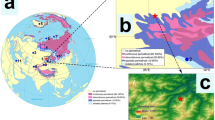Abstract
The delineation of the southern boundary of the latitudinal permafrost in the north of China in the period of late Pleistocene, i.e. the last glaciation maximum (LGM), has been hampered for two reasons. Firstly, previous studies were limited to the eastern part of the north of China, and, secondly, the ages of the permafrost had not been determined systematically. In this paper, we suggest that the southern boundary of the high latitudinal permafrost in the north of China is bounded by approximately 38–40°N (eastern part) and 37–39°N (western part) lines of latitude based on our interpretation of periglacial phenomena and their implication to the environment during the late Pleistocene, and this southern boundary is plotted for the first time. Also, we reconstruct the migration of the southern latitudinal permafrost boundary and the environment after LGM. It is pro posed that two cold stages occurred in the LGM at 26 kaBP and 23–13 kaBP, when the annual mean temperature was 8 –12°C lower than at present.
Similar content being viewed by others
References
Cui Zhijiu, Xie Youyu, On the southern boundary of permafrost and periglacial environment during the late period of Late Pleistocene in north and northeast China, Acta Geologica Sinica (in Chinese), 1984, 2: 165–176.
Zhou Youwu, Guo Dongxin, The main characteristic of Chinese permafrost, Journal of Glaciology and Geocrylolgy, 1982, 4(1): 1–19.
Dong Guangrong, Gao Shangyu, Li Baosheng et al., The palaeoperiglacial phenomena and their signification in climate stratigraphy in Ordos Plateau from Late Pleistocene, Geographical Research (in Chinese), 1985, 4(1): 1–11.
Zhang Ke, Liu Kaiyu, Yang Jingchun, The discovery and its significance of Late Pleistocene involution in the area of lower reach of Qingshuihe River, Ningxia, China, Acta Scientiarum Naturalium Universitatis Pekenensis (in Chinese), 2000, 36(5): 714–718.
Lanzhou Glaciology and Geocrylolgy Research Istitute, Chinese Academy of Sciences, The map of Chinese ice, snow and frozen soil, The Skeleton Declaration of Chinese Frozen Soil, Beijing: Chinese Map Press, 1988.
Northeast China Frozen Soil Research Co-acting Group, The basic characteristic of the permafrost distribution in Northeast China, The Symposium of the Second National Frozen Soil Academic Meeting of Chinese Academy of Geography and Chinese Academy of Civil Engineering (in Chinese), Lanzhou: Gansu People’s Publishing House, 1983.
Vandenberghe, J. Cryoturbations, Observed in Advances in Periglacial Geomorphology, New York: John Wiley & Sons Ltd, 1988, 179–198.
Wang Nailing, Yang Jingchun, Xia Zhengkai et al., The Cenozoic ear Sediment and Structural Geomorphology of Graben Systems in Shanxi Province, Beijing: Science Press, 1996, 1–72.
Yang Jingchun, Sun Jianzhong, Li Shude et al., Fossil ice wedges and Late Pleistocene environment in Datong basin, Shanxi Province, Sciential Geographica Sinica (in Chinese), 1983, 3(4): 339–344.
Wang Naiang, Wang Tao, Shi Zhengtao et al., The discovery of sand wedges of the last glaciation in the Hexi Corridor and its paleoclimatic significance, Journal of Glaciology and Geocrylolgy, 2001, 23(1): 46–50.
Gao Quanzhou, Dong Guangrong, Li Baosheng et al., The desertification at the south end of Badanjilin Desert from Late Pleistocene, Journal of Desert Research (in Chinese), 1995, 15(4): 345–352.
Gao Quanzhou, Dong Guangrong, Zou Xueyong et al., The stratigraphical records of the advance and retreat of eastern Asian monsoon at Chagelebulu section, Journal of Desert Research (in Chinese), 1996, 16(2): 112–119.
Xue Xiangxu, Zhou Weijian, Zhou Jie, Biological records of palaeoclimate and palaeoenvironment changes from Guanzhong Areas, Shaanxi Province during the LGM, Chinese Science Bulletin, 2000, 9: 853–858.
Li Baosheng, Ji Heling, Lü Haiyan et al., Processes of the deposition and vicissitude of Mu Us Desert, China Since 150 kaBP, Science in China, Series D, 1998, 41(3): 248–254.
Na Pingshan, Li Hanxue, Zhang Rumin et al., The ecological environment development at Genhe River of Great Xing’anling Mountain from later Late Pleistocene, Journal of Inner Mongolia Forestry College, 1997, 19(3): 5–11.
Li Jinsong, Huo Wenyi, The preliminary study of ground feature and it’s formation environment of the north segment of the Great Xing’anling, Sciential Geographica Sinica (in Chinese), 1999, 19(6): 543–548.
Yang Xiangdong, Wang Sumin, Xue Bin et al., The decelopment of sporo-pollen vegetation and Environment at Hulun Lake areas from Late Pleistocene, Journal of Paleontology (in Chinese), 1995, 34(5): 647–656.
Cui Zhijiu, The basic geomorphic characteristic of periglacial on Tibetan Plateau, Science Sinica, Ser. B (in Chinese), 1981, 6: 724–733.
Author information
Authors and Affiliations
About this article
Cite this article
Cui, Z., Yang, J., Zhang, W. et al. Discovery of a large area of ice-wedge networks in Ordos: Implications for the southern boundary of permafrost in the north of China as well as for the environment in the latest 20 kaBP. Chin. Sci. Bull. 49, 1177–1184 (2004). https://doi.org/10.1360/03wd0211
Received:
Accepted:
Issue Date:
DOI: https://doi.org/10.1360/03wd0211



